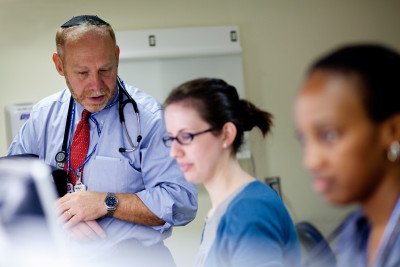
Pediatric oncologist Leonard Wexler with nurse practitioner Joanna Moulton.
An accurate diagnosis is essential to ensure that your child gets the most-effective therapy. Some people come to MSK thinking they have one type of cancer, but they learn through our precision testing that they have a different type of cancer. At MSK Kids, your child benefits from a team of pathologists (doctors who specialize in diagnosing disease) who are dedicated to the sarcoma program and are experts at identifying the features and subtle nuances of each patient’s disease.
How is rhabdomyosarcoma diagnosed?
Your child’s pathology team will analyze a sample of the tumor. This is called a tissue biopsy. We get this sample while your child is sedated with anesthesia. Sometimes your child’s surgeon can remove the entire tumor during the biopsy procedure.
What tests will my child need?
If we believe your child may have rhabdomyosarcoma, we will test for genetic changes that are unique to this disease. For example, one test can identify a genetic change found only in alveolar rhabdomyosarcoma. MSK researchers were the first to identify a different mutation in some people with the embryonal form of rhabdomyosarcoma. We do genetic testing of all newly diagnosed rhabdomyosarcomas.
Rhabdomyosarcoma can spread throughout the body. In addition to a tissue biopsy, your child will typically have imaging tests to determine if the cancer has spread. This process is called staging. Staging is important because it enables doctors to determine the best care plan for your child. Imaging tests may include CT scanning, MRI, PET scanning, and bone scans. Doctors may also do an examination of the bone marrow. We will let you know which tests your child will have and what to expect for each. Our team does all we can to ensure that your child is comfortable during these tests.
MSK Kids doctors combine the results of these tests to classify your child’s cancer as low risk, intermediate risk, or high risk. This determination is based on how far the cancer has spread and how well we expect your child to respond to treatment.
How is rhabdomyosarcoma staged?
The stage of your child’s cancer is based on where the tumor first developed, its size and if it has spread, the way it looks under a microscope, and how much surgery was possible at the time of diagnosis. There are four stages of rhabdomyosarcoma.
Stage I Rhabdomyosarcoma
The tumor can be any size and may have spread to nearby lymph nodes but nowhere else in the body. The tumor started in an area that has a better chance of being treated successfully, such as:
- the area surrounding the eye
- the head and neck region, except for the nasal passages, sinuses, middle ear, or upper throat (these are next to the membranes that cover the brain)
- a genital or urinary site, except the prostate or bladder
- the bile ducts
Stage II Rhabdomyosarcoma
The tumor is 5 centimeters or smaller and has not spread anywhere else in the body. However, the tumor started in an area that is more challenging to treat successfully, such as:
- the nasal passages, sinuses, middle ear, or upper throat
- the bladder or prostate
- an arm or a leg
- somewhere in the body not mentioned in stage I
Stage III Rhabdomyosarcoma
The tumor is 5 centimeters or smaller and has spread to nearby lymph nodes, or the tumor is larger than 5 centimeters and may or may not have spread to lymph nodes. The tumor has not spread elsewhere.
Stage IV Rhabdomyosarcoma
The tumor can start anywhere in the body, be any size, and has spread to distant areas, like the lungs, liver, or bone marrow.


